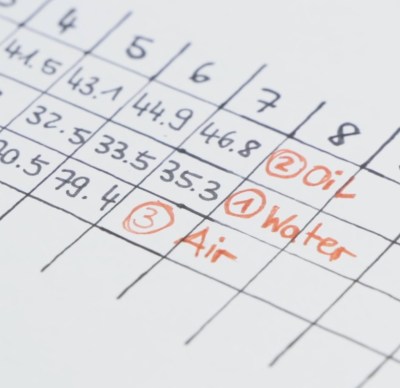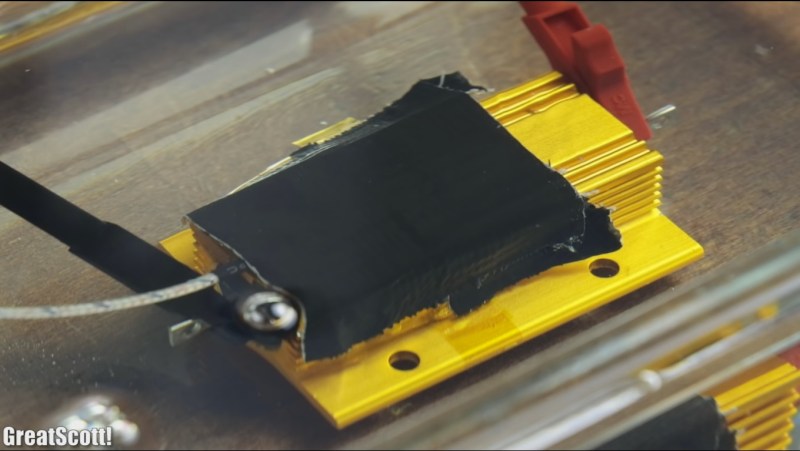Transformer oil has long served two purposes, cooling and insulating. The large, steel encased transformers we see connected to the electrical grid are filled with transformer oil which is circulated through radiator fins for dumping heat to the surrounding air. In the hacker world, we use transformer oil for cooling RF dummy loads and insulating high voltage components. [GreatScott] decided to do some tests of his own to see just how good it is for cooling circuits.
 He started with testing canola oil but found that it breaks down from contact with air and becomes rancid. So he purchased some transformer oil. First, testing its suitability for submerging circuits, he found that he couldn’t see any current above his meter’s 0.0 μA limit when applying 15 V no matter how close together he brought his contacts. At 1 cm he got around 2 μA with 230 VAC, likely from parasitic capacitance, for a resistance of 115 Mohm/cm.
He started with testing canola oil but found that it breaks down from contact with air and becomes rancid. So he purchased some transformer oil. First, testing its suitability for submerging circuits, he found that he couldn’t see any current above his meter’s 0.0 μA limit when applying 15 V no matter how close together he brought his contacts. At 1 cm he got around 2 μA with 230 VAC, likely from parasitic capacitance, for a resistance of 115 Mohm/cm.
Moving on to thermal testing, he purchased a 4.7 ohm, 100 watt, heatsink encased resistor and attached a temperature probe to it with Kapton tape. Submerging it in transformer oil and applying 25 watts through it continuously, he measured a temperature of 46.8°C after seven minutes. The same test with distilled water reached 35.3°C. Water’s heat capacity is 4187 J/kg∙K, not surprisingly much better than the transformer oil’s 2090 J/kg∙K which in turn is twice as good as air’s 1005 J/kg∙K.
He performed a few more experiments but we’ll leave those to his video below.
We’ve run across a number of tests running boards submerged in various oils before. For example, we’ve seen Raspberry Pi’s running in vegetable oil and mineral oil as well as an Arduino running in a non-conductive liquid coolant, all either overclocked or under heavy load.
















Imagine he says something about cost.
Water is usually better at transferring heat. The downside for a transformer though is that water freezes and conductivity is sensitive when impurities are present in it. In many cases the oil is a better choice because it is not all about heat transfer as much as it is about stability. The oil changes temperature more slowly and helps keep thermal swings dampened in utility transformers. A lot of utility transformers do not actually move the oil, the oil is just present to conduct the heat to the outer finned case of the transformer.
I was trying to find some definitive info on transmission fluid, as an easy to find alternative to mess with (Bear in mine it eats teflon, but safe on many plastics) but getting solid specs in a hurry seemed like nailing jello to the wall…. but anyhoo, this turned up and seemed interesting https://www.nrel.gov/docs/fy15osti/63969.pdf
You should probably figure out how to remove the bear from your transmission.
ROFL, yeah, that was supposed to be a mind,
This is the first I’ve heard of any interaction between transmission fluid and teflon. Can you elaborate?
Yeah on reflection seems to be one of those old wives tales I picked up years ago. Possibly originating due to exhortations not to use teflon tape on hydraulic systems or else little shreds of teflon could block small valve orifices and clog up valve bodies etc.
ATF is either a blend or pure synthetic oil. Teflon should be perfectly fine with it…
Can you use transformer oil to cook food? Seems like it would be an ideal liquid for pan or deep frying food with its excellent thermal qualities. Ingesting it should help you resist electrocution in the future and help cool off your insides better if its a hot day. And because its not derived from natural sources it should be both vegan friendly and gluten-free.
Yes! You can also drink diesel if you really want to. It’s tangy!
I like MEK more than diesel…and it adds an “I might die” after note to cocktails.
Just use Flourinert…its probably safe and fat free
https://youtu.be/a4gYv2BK-HQ
But expensive :(
there was an attempt to provide some non digestible fat for cooking oil (in US of course).
It didn’t end well on the end side…
Yep, non-digestible mean that it remains a lubricant all the way to the end of your system. Surprised that anyone thought that would work out well.
Of course. Quicker one can slide the old food out. The quicker one can slide in the new.
Can you? Yes!
Should you? Probably not!
Is this a new idea? Nope!
https://www.google.com/search?q=fried+in+transformer+oil&ie=utf-8&oe=utf-8
I think I miss the point in many of his videos…yes water has a high heat capacity than oil, in fact it probably has a higher heat capacity than most common materials…yes transformer oil has a very low electrical conductivity, that’s why it exists.
Similarly I didn’t get the build vs buy an SSR…of course you can buy on that performs better than one you built from discrete components.
I don’t know…I must be missing something.
better in what way? they both use roughly the same components and the one you build won’t be using floor sweepings like the dirt cheap with shipping Chinese one
Transformer oil is essentially mineral oil. Puget systems built a mineral oil submerged PC a few years back because of its dialectic and heat conductive properties.
That’s been an old party trick among the custom pc folks for a while. Stick it in a fish tank, use the same case fans to circulate the oil, drop in the evap coil of a mini fridge if you’re feeling crazy and want to keep it real chilly.
The problem comes when it’s time to upgrade your graphics card and you have to clean all the little contacts in your PCI slot. People end up putting the mobo in the dishwasher. Yeah, really. Not many people think it’s worth it, understandably.
I used the radiator from an air conditioning unit. Not sure if it was properly drained of whatever was in there originally but I survived with only tribial brain dablage.
Did somebody say my name?
Why would you need to clean the contacts? Is the oil so viscous and the pins so weak they cannot make a connection?
Because the oil is non-conductive and the pin slide over the thin layer rather than cutting through the oil. Remember that oil in most cases is intended to forms a thin film barrier over metals. That’s why it is used as a lubricant. You would probably get some kind of connection on something like a bus connector but the resistance of that connection is non-determinant and buses don’t like impedance mismatches.
I’ve always wanted to run a decent computer in oil. If changing components could you not just use wd40 on the contacts or actual switch cleaner or degreaser before changing?
Transformer oil is mineral oil. Baby lotion without the lavender scent. I work in the transformer industry. It’s dielectric properties are great until it absorbs moisture or is otherwise contaminated.
When I took on responsibility for a load HV gear (power supplies, transformers, rectifiers) at work, one of the 1st things I asked to see was the maintenance and oil sampling records. It turned out one of the units had been overlooked. When we had the results back, one had about 30 ppm water in the oil. That was enough to lower the dielectric withstand to nearly half what it should have been.
30ppm is quite high. 10 is the limit for a new transformer but we typically ship much less. If you have 30ppm in the oil you likely have 3000ppm in the insulation!
Yes, exactly because the water does not want to combine with the oil it will live in the insulation instead. I have done some work with high power transformers and one of the ways to correct the issue was to run the transformers at a high load increasing the temperature above the boiling point. That would cause the water to become vapor and vent from the transformer. Just changing the oil does not help much because the water remains in the spongy insulation.
Surely specific heat capacity is only a fraction of the relevant properties for cooling electronics in fluids? Conductivity, viscosity, density change with temperature, Reynolds number, Nusselt number etc?
I worked in a place that used Fluorinert for checking chips for fractures. You dunk a flat of chips in a glass vat of very hot Fluorinert and look for bubbles. One of the girls tripped and one of the very expensive containers of the Fluorinert hit the ground and spilled all over. Outside of the cost, which back then was over $400 for a 1 or 2 liter container, the stuff in non wetting. It was funny watching her try to clean it up with paper towels.
Depending on what you are going to be dunking into it, deionized water has a lot of good characteristics. The trick is keeping the ions out of it.
i believe the resistance he measured was ohms per square, not ohms/cm.
ohms per square what?
Truth be told I don’t know which one he actually measured, but It’s just ohms/sq the units of length cancel out.
https://en.wikipedia.org/wiki/Sheet_resistance
In the video he measures resistance over a distance and calls it ohms/cm (3:43 in the video). But I think resistivity would be more appropriate for what he did https://en.wikipedia.org/wiki/Electrical_resistivity_and_conductivity, though that’s ohm*meter.